Introduction: In this article, Gena Philibert-Ortega writes about something that was a big part of our ancestors’ lives, but not so much today: the handkerchief. Gena is a genealogist and author of the book “From the Family Kitchen.”
I distinctly remember the first time I learned about women’s handkerchiefs. I was around 11 years old shopping at an antique store with my parents and an aunt (my mother’s sister). My aunt walked up to a booth and purchased a decorative hankie from a bygone era. She then explained that she preferred them to paper tissues.
I remember being fascinated by the basket of hankies in that antique booth that ranged from the highly embellished with tatted edges or embroidery designs, to the colorful, and the plain white. But I also wondered why someone would use them – and why we didn’t anymore.
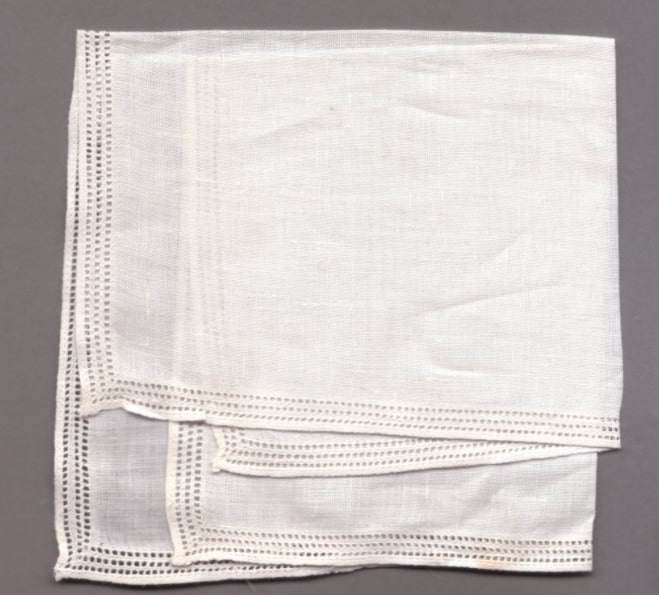
Having recently talked with some quilters about quilts made with vintage hankies, I decided to take a look at historical newspapers to learn a little more about their original popularity and why they fell out of favor.
Handkerchiefs in Historical Newspapers
Handkerchiefs have a long history, but if we fast forward to the early 20th century, handkerchiefs were a popular gift and part of every man and woman’s must-haves. There’s no doubt that handkerchiefs were part of everyday life. I found newspaper articles about “handkerchief showers” for brides-to-be and handkerchief “events” which were big sales at local retailers.
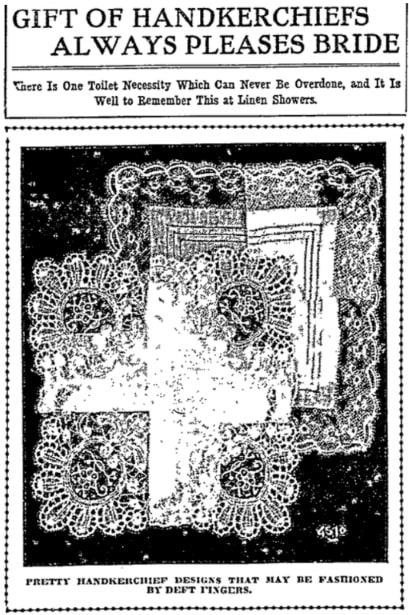
They were so popular that at some point, people had too many handkerchiefs. Newspaper articles shared ideas for creative ways to reuse them. This 1915 newspaper article suggested that those extra handkerchiefs could be used to make a bureau scarf, a baby cap, or a party favor.
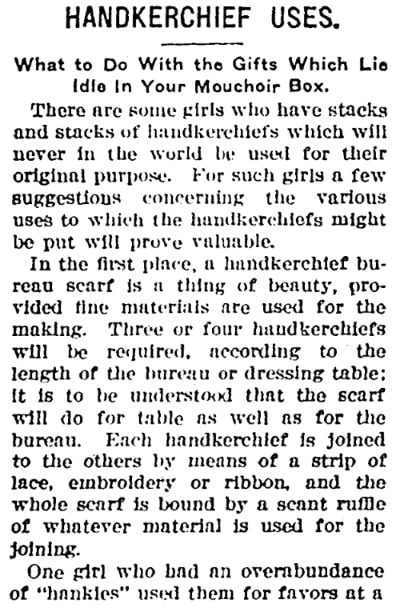
This next newspaper article claimed that a new 1928 fad transformed the handkerchief into a “trinket of fashion” by tying it to your wrist so that it would flutter as you dance.
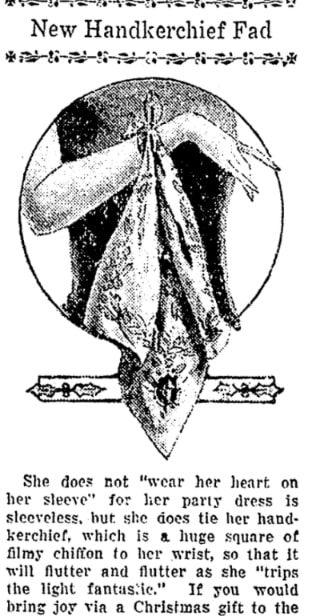
Newspaper articles about handkerchiefs, buying them, gifting them, and reinventing them were commonplace. They were the must-have accessory. So, what happened?
Sanitary Handkerchiefs
Concerns for public health and the problems that handkerchiefs caused, as something that would become wet and filled with germs, started to be addressed. Newspaper articles about providing children with sanitary handkerchiefs started appearing in newspapers in the 20th century, like this one from Dallas in 1912 reporting that Dr. Horace B. Blan found that handkerchiefs were the cause of infectious diseases. The article discussed Dr. Blan and his study, which found that the majority of used handkerchiefs were filled with germs, including tubercular bacteria.
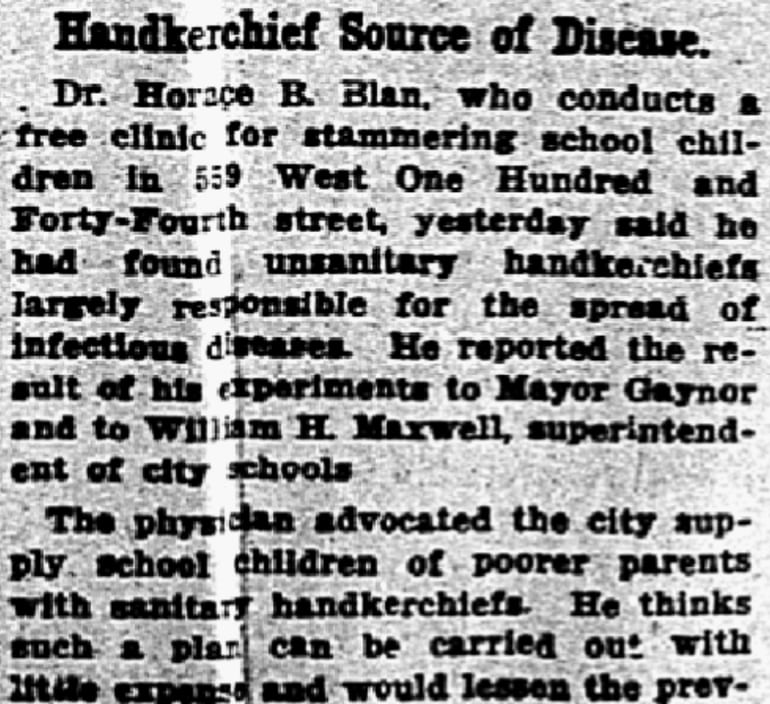
Although handkerchiefs were identified as a cause of spreading illness, they were also seen as a tool to stop the spread of germs. Early 20th century concerns included spitting and uncovered coughs. Handkerchiefs were identified as something to use to cover a cough. This especially became a concern during the 1918 influenza pandemic.
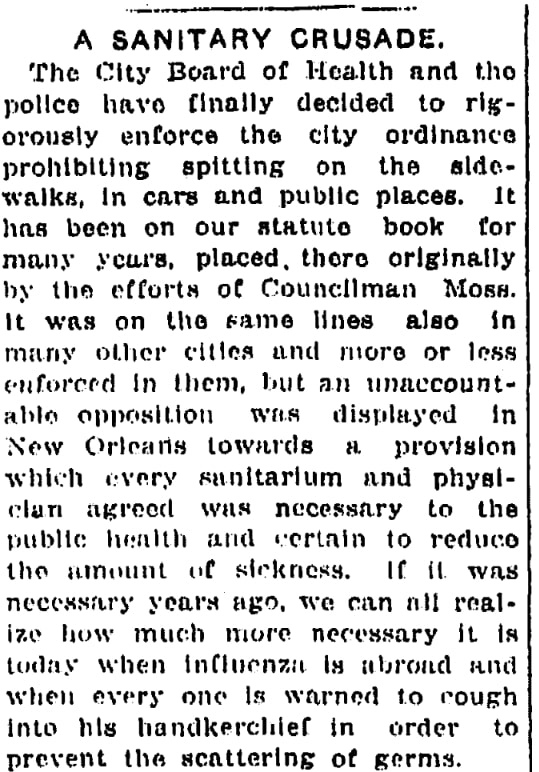
Newspaper articles addressed unsanitary handkerchiefs and other linens by discussing way to best launder them in a “sanitary” way. This 1922 example explained that the way to wash laundry had changed and that washing everything together was not sanitary. Items should be separated and washed in groups so that a tablecloth wasn’t washed with undergarments, for example.
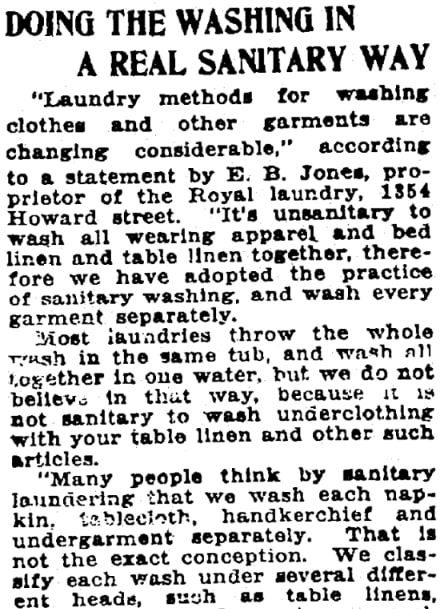
World War I helped to bring attention to a paper product that led to a new type of disposable handkerchief. During World War I, nurses noticed that a crepe paper gas mask filter was also good for use as a menstrual pad. By 1924, the Kimberly Clark company suggested an additional use for their paper product: to remove cold cream. By the 1930s, the paper handkerchief had gone from a sanitary way to remove cold cream to a disposal handkerchief for colds.*
Marketing focused on fabric handkerchiefs being “damp, disgusting” and promoted “soft, dry Kleenex disposable tissues” as more sanitary, and also cheaper than laundering handkerchiefs.
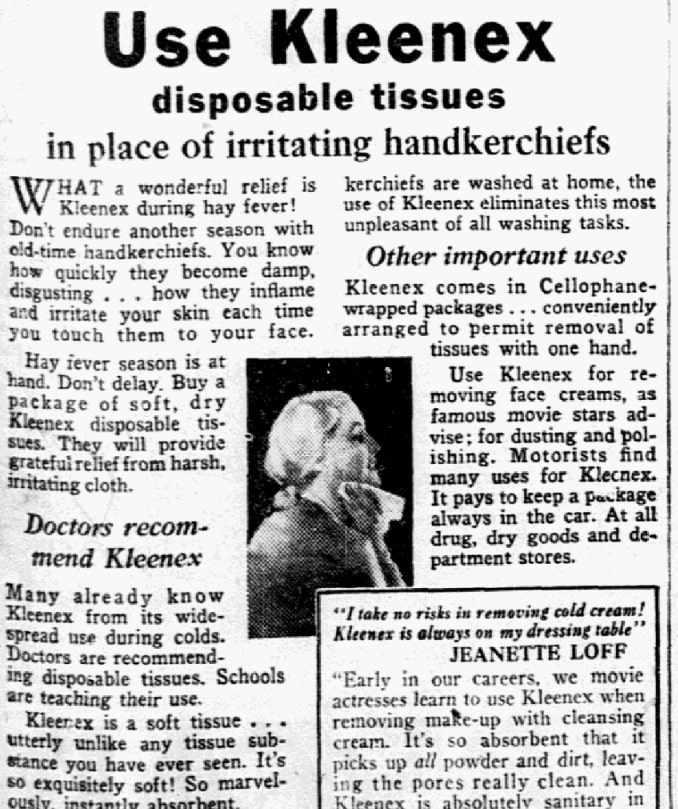
History Tip: Why did women need a special product to help take off cold cream? Cold cream is a face cleanser and moisturizer made from water, oil, and wax. This thick cream is best removed with a washcloth or tissue paper and not with water like other cleansers.
The End of an Era
In the end, smart marketing and public health concerns marked the demise of the cloth handkerchief for the most part. Today handkerchiefs are mostly seen as an accessory to men’s suits, but they are no longer the must-have for everyone. Times change and concerns about health led to innovative uses for existing products.
* “Kleenex Brand Story,” Kleenex (https://www.kleenex.com/en-us/about-us/our-history#:~:text=1924,product%20%2D%20%E2%80%9Cabsorbent%20kerchiefs.%E2%80%9D: accessed 18 October 2023).
Explore over 330 years of newspapers and historical records in GenealogyBank. Discover your family story! Start a 7-Day Free Trial
Note on the header image: lace handkerchief. Credit: Goldi64; Wikimedia Commons.

When I was a young girl in the 1960s, my grandmother always reminded me to have a clean hanky, with a dime tied in the corner, when I left to go on dates. I had lots of beautiful handkerchiefs because Grandma crocheted or tatted them for me.
What a great idea, Sandie! I’m assuming that the dime was so you could call home if you needed to. Thanks for sharing that memory with us.
Yep! my grandmother did the same thing. Such a lovely memory now. I recently unearthed two beautiful lace handkerchief’s . I’m keeping them framed for now but they will go to a local historical society upon my demise.
A lot of small children (including my mother) were told they must always have a clean hankie, so they never used them because they had to be kept clean!
Susan, thanks for that memory!
In the 1950s and 60s, my grandmothers were never without a handkerchief. Plain or print for everyday; beautifully embroidered, monogrammed, lace edging, etc., for church and social occasions. I still have several that I inherited, and my daughter had one of them incorporated into her wedding bouquet.
What a great, creative idea! Thanks for sharing that Debra!
I have a few of my mother’s handkerchiefs… most with embroidered flowers, all with lace. My mother died soon after I was born so these are very special to me. I remember learning to iron with a “sad iron” and my grandmother’s handkerchiefs are what I practiced on!
Thank you Cathy for sharing those memories with us. Handkerchiefs are important heirlooms for so many people.
I remember in the late 50s and early 60s my dad was in the air force so he wanted all of his clothing items to be ironed and starched. This included pillow cases and handkerchiefs. So I ironed a lot of handkerchiefs in my younger years.
I bet you did Susie! I guess the nice thing about ironing them is that they are small and fairly easy to iron.
I still have several and use them. I have small, dainty ones for fancy dress and big ol’ farmer ones for around the house.
What a great personal collection! Thanks for sharing that Valerie!
When I was a child, my sweet grandmother gave her granddaughters cute little handkerchiefs for our birthday gifts. When I went to grade school my mother wrapped some coins in a corner of the hankie to use to pay for my lunch. It kept the coins quiet and safe. One of my jobs was to iron the handkerchiefs each week.
What wonderful memories! Thanks for sharing them, Sandra.
Interesting article, Gena. When I hear the word handkerchief, I’m reminded of the movie “The Intern.” The retired gentleman tells the young men that a gentleman carries a handkerchief to give to a lady in distress and impress her.
Thanks, Bonnie! I appreciate it.
I see I am now relegated to the “ancestor” category. As a little girl in the 1950s I remember carrying around a soggy handkerchief when I had a cold. I vaguely remember them as having a decorative print. Dad had a large collection of white handkerchiefs that he carried in a front suit pocket to work. I don’t remember when we started using Kleenex.
Not at all, Jeannie! I do know more recent family members who used handkerchiefs, but it’s always interesting to take a historical item and see how their use changes over time.
My husband and I recently were talking about this. Our parents always had handkerchiefs. As a child these were my trial pieces to iron when they came out of the wash.
Most of the ones they had were plain, but as time went on, I did receive some very dainty ones and some that were tatted. I feel I must have one of these somewhere in my memorabilia.
My daughter once asked why old people always had tissue in their pockets. I said it was a remnant of the good ol’ days when handkerchiefs were the tissue of the day.
I was just talking to someone about tatting the other day. Tatting definitely made an item seem more “fancy.” Thanks for sharing your memories, Carol.
My father carried a handkerchief in his pocket every day of his adult life. My first chore was ironing them. He passed away in 2010 but I’ve kept one of his handkerchiefs in my memory box.
What a wonderful keepsake to remember him by. Thanks for sharing that Jan.
Is this an American thing to not use a hankie anymore? I live in New Zealand and I always take a hankie with me if I’m leaving the house.
I know very few people who use hankies anymore Nicola. I think Kleenex is probably preferred.
I was given one of mom’s handkerchiefs when she passed away.
When I have happy or sad moments with tears I use it for my comfort.
I’ve since bought a package of really nice ones for my use, here and then.
So, when I pass away they can distribute my handkerchiefs to my loved ones for a memory of me when they need comfort.
They can be a great item to remember someone by. Thanks for sharing with us Lydia.
I was always given a handkerchief when I was home sick with a cold because Mom said it wasn’t rough on my skin. I gave up paper tissues in the early 90s because I thought they were wasteful, but after I got married my husband and I struck a balance between paper tissues and cotton hankies. Right now, we use both, trying to balance being sanitary with not being wasteful.
Sara, judging from the comments, it seems like other people use them, but it is important to consider the sanitary issues involved with using handkerchiefs. Thanks for commenting on my article.
When I was young it was my job to hang the laundered handkerchiefs on the fence (because I couldn’t reach the clothesline) and then to iron them when dry. I have piles of my mother’s, grandmother’s, and father’s handkerchiefs.
Marilyn, what great memories! Thank you for sharing those with us, and enjoy your family’s handkerchiefs!
Also, I’ve seen some people frame a selection of family handkerchiefs. This might be a good way to display yours.
I was the youngest of three girls. My ironing duty was my daddy’s handkerchiefs. So tiring! So I asked him not to use so many. Being a daddy’s girl, he started using Kleenex. I only had 1 or 2 to iron a week!
I received many child hankies – most were Walt Disney.
I inherited beautiful hankies from 2 grandmas, mother and aunt. My collection numbers over 60!
Wow! 60 handkerchiefs Sherri! What a treasure. You might want to consider what I posted above. Framing some of that collection would allow you to share them and your stories with family. Just a thought.